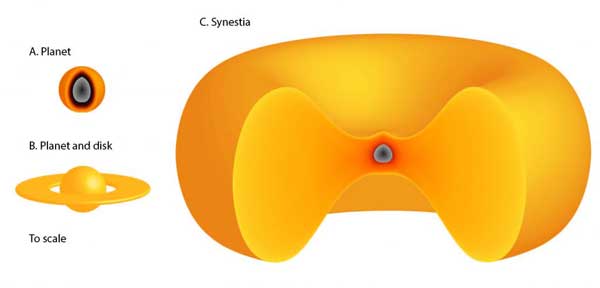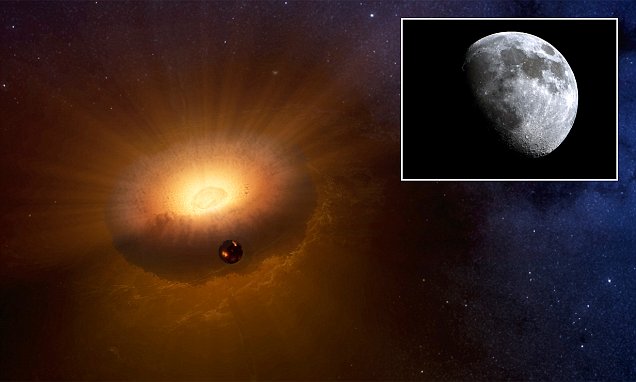Two Realms Ceased to Exist in a Planetary Clash — Paving the Way for a Fresh Beginning
The abrupt intensification of a star’s luminosity, followed by a subsequent sudden fading, indicates a catastrophic encounter between two sizable celestial bodies, occurring two years apart.
Astronomers have observed a dramatic event in the distant Puppis constellation, over 1,800 light-years away from us, where two nascent planets collided around a youthful, Sun-like star. This collision likely turned both planets into vapor, forming a substantial cloud of debris still orbiting the central star. Over time, this vaporized material will coalesce to create a much larger celestial body. Scientists are closely monitoring this intriguing process.
This planetary crash offers a rare insight into the tumultuous process of planet formation and presents exciting opportunities for further exploration, particularly with the James Webb Space Telescope (JWST). Interestingly, the lead researcher, Matthew Kenworthy from Leiden University in the Netherlands, stumbled upon this discovery unexpectedly.
Initially, Kenworthy was conducting research on a different subject when, in late 2021, he noticed a fading star alert. The All Sky Automated Survey for Supernovae (ASAS-SN), a network of 24 sky-monitoring telescopes, had issued a notification about the star’s abrupt dimming. Over the following months, ASAS-SN recorded a jagged decline in the star’s brightness, followed by a return to its typical luminosity.
Kenworthy shares, “When the ASAS-SN group announced this event, I began tracking the fluctuations in the star’s brightness. It didn’t occur to me that there was more to it until a Twitter post by team member Arttu Sainio pointed out that the star had previously brightened in the infrared nearly 1,000 days earlier.”
This vital clue eventually led astronomers to the conclusion that two young worlds had met their demise, serving as the building blocks for a much larger planet. The resulting debris stream from the collision obscured the star’s light 2½ years later, in 2021. However, comprehending the entire sequence of events required time and extensive observations.
Revisit the Collision Point
Kenworthy headed a research team that analyzed data from the Las Cumbres Observatory Global Telescope Network and the Wide-field Infrared Survey Explorer, both before and after the abrupt decrease in the star’s luminosity. The investigation revealed that about 2½ years prior to the star’s sudden dimming, a significant event occurred around the star, resulting in a new heat source and, consequently, infrared emissions. This event, which took place in 2018, raised the temperature of the material to approximately 1,000K (1,340°F), and this material has maintained its elevated temperature ever since.
In their study published in Nature this week, the team proposes that a massive collision transpired between two celestial bodies of super-Earth to sub-Neptune dimensions. These two worlds were situated at a distance ranging from 2 to 16 astronomical units (a.u.) from the star, with Mars, for reference, orbiting the Sun at 1.5 a.u. and Saturn at 9.5 a.u. The precise location of the collision in relation to the star is not definitively determined, as it wasn’t directly measured from an image but rather inferred from the variations in the system’s brightness known as light curves.
The researchers acknowledge the possibility that the infrared brightening and the starlight blockage could have been separate occurrences. Nevertheless, they argue that the likelihood of two such events being unrelated is even more improbable than a planetary-scale collision.
Based on their calculations, a collision of this magnitude would lead to the vaporization of both celestial bodies, with a relatively small portion of the debris remaining in orbit around the star. “Over the course of a few orbits, which spans several hundred years, the dust will gradually coalesce into a ring encircling the star,” Kenworthy explains. Currently, the debris forms an extensive, elongated cloud roughly a quarter of an astronomical unit in size, with the dust density being substantial enough to obstruct a significant portion of the star’s light as the cloud passes in front of it.
It seems that ASASSN-21qj is slowly rising back to normal, after a very exciting year… based on the light curve gradients, this object is at least 0.23 au in size… thank you @SuperASASSN for posting these fascinating light curves! @space_r2 @EricMamajek pic.twitter.com/3MYj2C4xu0
— Matthew Kenworthy (@mattkenworthy) December 27, 2021
Nevertheless, a significant portion of the mass has retained its gravitational cohesion, albeit in a vaporized state. Simon Lock, a member of the team hailing from the University of Bristol in the UK, had previously put forward the notion that these remnants could potentially form a structure known as a “synestia,” resembling a cloud in the shape of a donut with material spanning its center (somewhat akin to an exceptionally fluffy Danish pastry). This collision offers the researchers a unique opportunity to validate this concept.

Simon Lock and Sarah Stewart
Planetary Collision or Dusty Disk: A Matter of Interpretation?
Kate Su, from the University of Arizona, who was not involved in the research, emphasizes, “Observationally, there is no doubt that the scale of this violent collision, particularly the amount of mass involved, sets a new record. The real question at hand is, what is the ‘correct’ interpretation?”
An alternative explanation has been presented by another team led by Jonathan Marshall from the Academia Sinica Institute of Astronomy and Astrophysics in Taiwan, which is published in the Astrophysical Journal. They propose that the observed phenomena could be attributed to an uneven dusty disk encircling the star, possibly originating from the disintegration of comets. This group also draws attention to a notable resemblance between this celestial system and the enigmatic Boyajian’s Star.
Both hypotheses have the potential to account for the observed phenomena, highlighting the need for further investigation. Kate Su adds, “This underscores the fact that our knowledge about significant collisions within exoplanetary systems remains limited.”
Enhanced and more comprehensive observations are essential for shedding light on this mystery, and the James Webb Space Telescope (JWST) presents a promising avenue for this endeavor. Despite the system’s relatively faint appearance due to its distance, it remains within the range of the keen-eyed infrared telescope.
In fact, when the dust cloud completes more of its orbit around the star, Matthew Kenworthy plans to request observation time with JWST to attempt direct detection of the cloud through the reflection of the star’s light. Anticipation is high regarding what they will unveil: “It’s an incredibly exciting prospect!”
Source: SkyAndTelescope
Do not forget to share your opinion with us to provide you with the best posts !




0 Comments